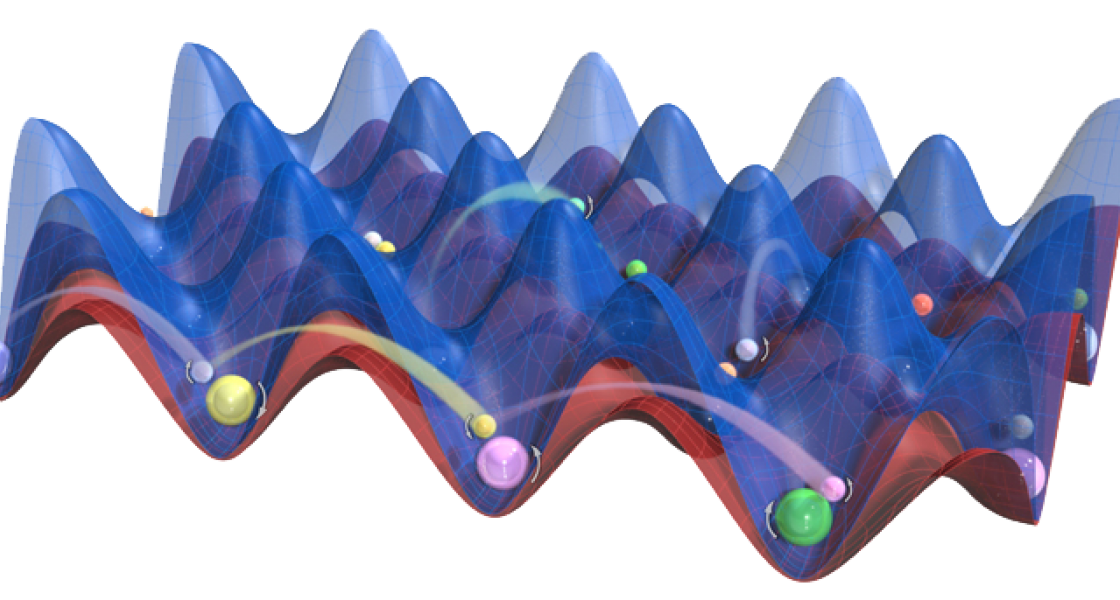“Nature is built quantum mechanically,” says Fellow Jun Ye, who wants to understand the connections between atoms and molecules in complex systems such as liquids and solids (aka condensed matter). He says that the whole Universe is made of countless interacting particles, and it would be impossible to figure out the myriad connections between them one particle at a time, either theoretically or experimentally.
Fortunately, in 1986 Richard Feynman envisioned a work-around for the challenge of understanding complex systems one particle at a time: He suggested building quantum mechanical simulators complete with well-understood knobs to control the interactions in the system, then sitting back and watching the system evolve.
“The idea is to let Nature solve the problem,” Ye explains. “You can assemble precisely controlled atoms or molecules to mimic complex materials, add in well-defined interactions between particles, and then watch the system dynamics unravel themselves. For example, the state of the matter might jump from one configuration to another simply because of quantum fluctuations.”
Ye will soon get a chance to try his hand at building a quantum simulator, thanks to Fellow Ana Maria Rey and her theorist colleagues from the University of Colorado, Harvard, the Joint Quantum Institute, the Harvard-Smithsonian Center for Astrophysics, and the University of Innsbruck.
Rey and her colleagues have come up with a “perfect simulator of condensed matter systems” made from ultracold alkaline earth atoms. One such atom, strontium (87Sr), is already famous for its roles in the Ye group’s creation of a high-accuracy optical atomic clock. Alkaline earth atoms may also one day play a role in quantum information processing (See JILA Light & Matter, Spring 2009).
When alkaline earth atoms are loaded in optical lattices (egg carton-shaped energy wells formed by interacting laser beams), they can be used as quantum simulators of many-body phenomena, according to Rey and her colleagues. They have shown that one of the features of alkaline earth atoms is particularly important for creating quantum simulators: the nuclear spins of alkaline earth atoms are almost completely decoupled from the two valence electrons under carefully selected conditions. This decoupling means that the atoms can be used to create relatively large systems with an unprecedented degree of symmetry. This symmetry prevents spin-changing collisions between the atoms, something that is very attractive for a laboratory quantum simulator.
The proposed quantum simulator would allow researchers to study 87Sr atoms simultaneously in the ground state and in a stable optically excited state. The atoms would be placed in different optical lattices according to their electronic states; the lattice filled with ground-state atoms could be moved relative to the stationary lattice containing the optically excited atoms. Each lattice could have atoms with different nuclear spins, however. The nuclear spins would control how the atoms interact with each other.
The two optical lattices could be prepared either deeper or shallower as compared to one another. This controllability would make it possible to create atomic analogs of condensed matter systems exhibiting nontrivial interplay between spin, electronic orbitals, and charge. The ground and excited states in the atomic system will play the role of the electronic orbitals, and the nuclear spin will play the role of the electronic spin. The mass of the atoms will be the analog of the electron charge because when atoms move, they create a “mass current.” Like electrical current, mass transport can be measured.
The new quantum simulator promises to open the door to understanding the physics of some very exotic materials, including (1) heavy fermion materials, in which spin interactions between a cloud of conduction electrons and a band of localized spins causes the conduction electrons to behave as if they had masses nearly three orders of magnitude larger than those of bare electrons, (2) exotic superfluids that arise because of pairing between more than two atoms, (3) chiral spin liquids that remain magnetically disordered even at zero temperature. These liquids have excitations like those of anyons. Anyons are weird particles with fractional charges that seem to be something in-between a boson and a fermion. Chiral spin liquids have long been sought in condensed-matter systems, but never found. However, they are predicted to be one of the possible ground states of 87Sr in a deep lattice (with one atom per site) if the atoms can be cooled to very low temperatures of about 100 pK .
If all this isn’t enough, the quantum simulator could even make alkaline earth atoms interact with a Bose-Einstein condensate (BEC). If the alkaline earth atoms are in a chiral spin liquid phase, they will generate effective magnetic fields that will cause the formation of vortices in the BEC. Richard Feynman would be proud of all the things the simulator will be able to do.
Jun Ye is excited. “Ana Maria has proposed a very challenging, but doable experiment for us to do in the future,” he says, noting that he can employ the precision measurement technology he uses with the optical atomic clock to control the quantum simulator. “This is a very exciting exchange between theory and experiment that is leading us in new scientific directions.” - Julie Phillips




